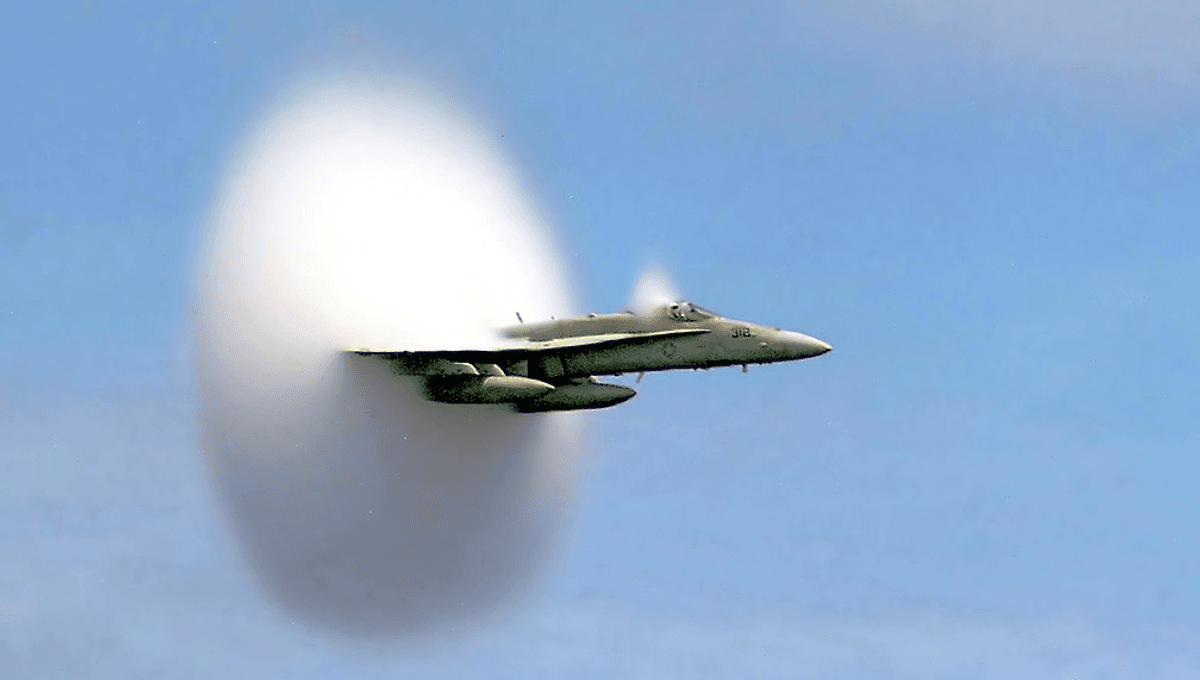
Mach numbers compare the flow velocity of a fluid past a boundary to the speed of sound. Crucially, however, there is no universal speed of sound. Instead, sound travels at different rates depending on the medium the sound is travelling in and the temperature. Consequently, Mach 1 is equal to the local speed of sound, that is the speed in the medium through which an object is traveling.
The local nature of the measure might make it seem unimportant, compared to universal constants. For anyone trying to surpass Mach 1, it’s sound’s local speed that matters, and it can become important for those nearby as well if they succeed.
Mach 1 can vary dramatically depending on temperature and the material through which one is moving, as well as weakly with some other factors. However, while there is a Mach 1 for water or any other medium, it’s almost always used to refer to movement through air, particularly at the heights at which airplanes usually fly.
In air, Mach 1 is determined primarily by temperature, which decreases with altitude. Consequently, while the speed of sound is frequently given as 343 m/s (772 mph, or 1,242 kmph), representing room temperature, airplanes can often break Mach 1 at less than 300 m/s.
A solid object traveling through gas creates pressure waves in front of and behind it. These travel at the speed of sound in that gas, and for something as large as an aircraft they’re a force to be reckoned with. As the object’s speed increases, the waves get forced together, which at Mach 1 creates the famous sonic boom, which is not only disturbingly loud, but can rattle objects hard enough to cause pieces of houses to fall off. Objections to this inevitably led to restrictions on flights that would cause such booms. These in turn have raised costs, which is why you can’t now buy a passenger flight from New York to London in three hours anymore, although NASA hopes to fix that.
Even approaching Mach 1 poses problems. As aircraft get close to the speed of sound, they experience greatly increased aerodynamic drag and can become harder to control. This led to Mach 1 being referred to as the “sound barrier”, with suggestions in newspapers it was impossible to exceed.
An inaccurate analogy between Mach 1 and c, the speed of light in a vacuum, has led many people astray. Exceeding Mach 1 was considered almost impossible to do safely in an aircraft, until Chuck Yeager did it, leading to the term the “sound barrier”. Consequently, once the apparent limit was broken, and jets proceeded to exceed the speed of sound on a regular basis, many people assumed the speed of light would prove similarly permeable.
This contributed to concepts like Warp Factor 5 in Star Trek being widely accepted, as if this was just an engineering problem like building planes that can fly at Mach 5. It makes for great science fiction, but the problems start when people believe it despite the real differences.
Importantly, the fact that the local speed of sound could be exceeded was never in doubt. The crack of a bullwhip comes from the small sonic boom when a skilled user makes the cracker travel faster than Mach 1. Thunder is produced by a similar shockwave in the air. The challenge was to scale up.
Meanwhile, more than a century after Einstein published the theory of Special Relativity, we have no evidence of anything traveling faster than the speed of light, whether it be tachyons or ordinary matter accelerated to pass that speed.
By the way, the official definition of Mach 1 refers to the speed at which a fluid flows past a boundary, but we usually think of it as the speed at which a solid object like an airplane moves. Don’t be concerned by this discrepancy. Since all motion is relative, if the speed at which a plane is moving is measured compared to the air around it, rather than to the ground, the air will be flowing past it at the same rate in the opposite direction. It’s the relative motion of the two that matters. Consequently, a plane traveling with the wind can travel faster relative to the ground, than the speed of sound in the air it’s moving through, without exceeding Mach 1 and creating a sonic boom.
Source Link: What Is Mach 1 and Why Does It Matter?